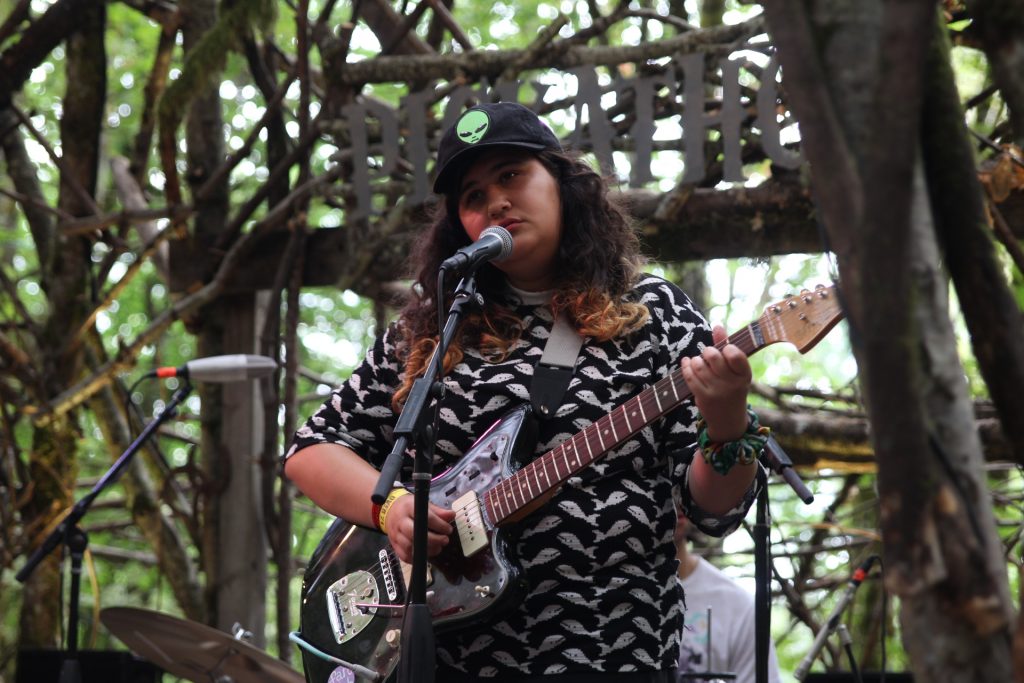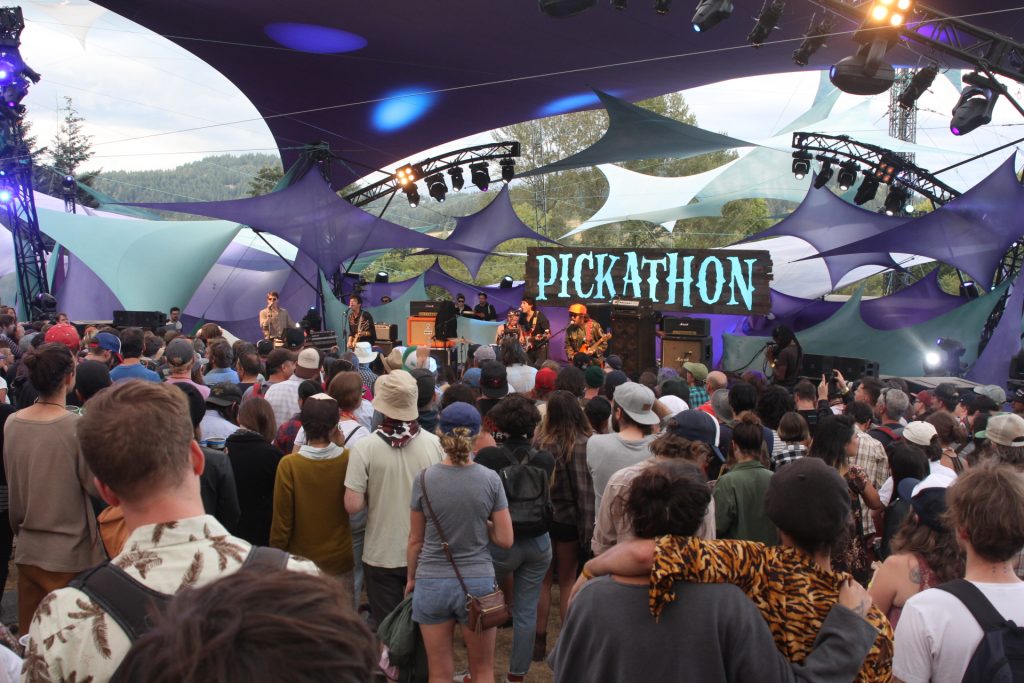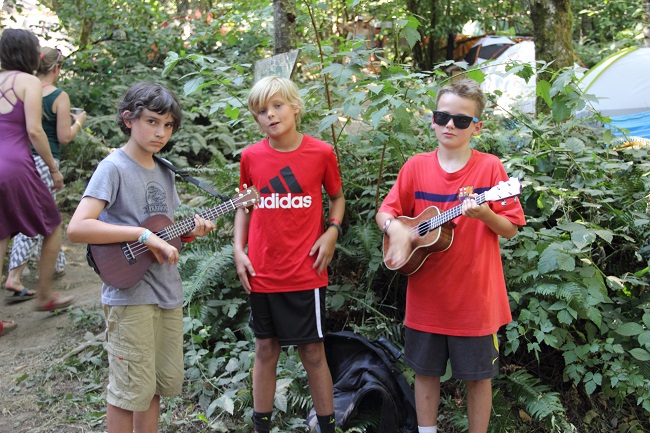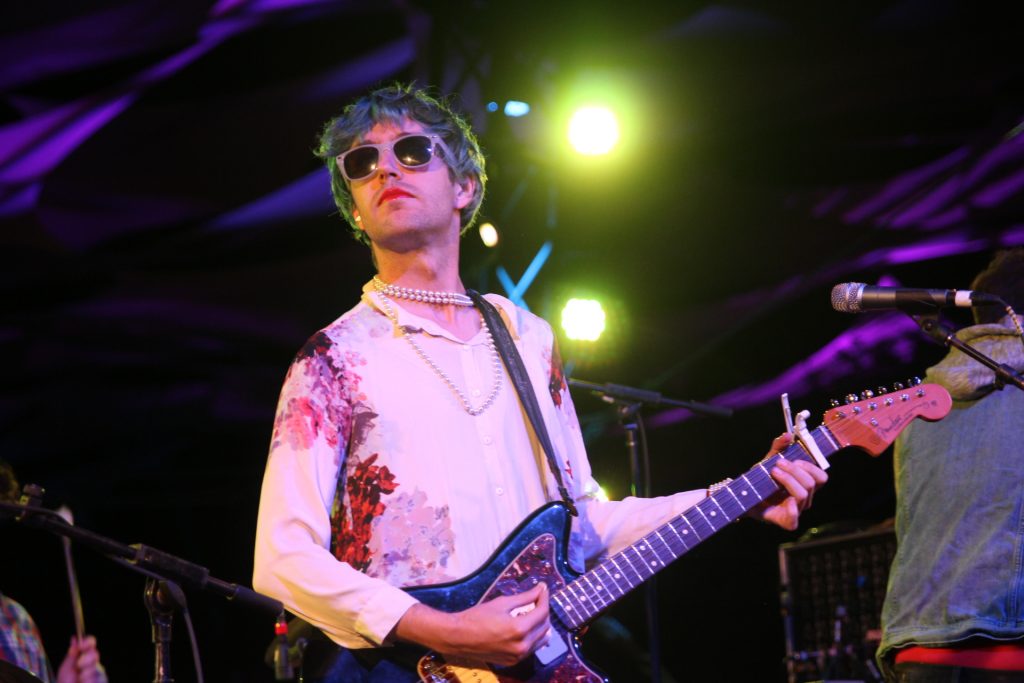
Ellen Kempner of Palehound played Pickathon’s Woods Stage
It wouldn’t be quite right to give a festival like Pickathon a traditional review because it’s so far from a traditional festival. A “Best and Worst of” isn’t befitting either because the folks at Pickathon have created something more than just a place where artists play sets of music. After nineteen years of producing the small eco-friendly festival on a farm about forty minutes south of Portland, Oregon, Pickathon has figured out how to set themselves apart from the rest. They’ve nailed down how to create more of a musical playground and experience that’s far different than what we’ve come to think of as a festival in 2016. In the process, they’ve very covertly created one of the best festivals in the country and probably the world without compromising any of the principles which helped them get there. Unsurprisingly those principles seem to align with the unique city of Portland itself but not in any sort of tacky or satirical way that you might have seen depicted in last season’s Portlandia episode.
Perhaps what defines it the most is the festival’s intent on creating something so well thought out and organized that the experience of being there for three days in August is more important than any single artist or band. In that affect, a “Best and Worst of” review that focuses on performances of artists who shined and others who sorta blew it, just wouldn’t make any sense. In addition, the lack of a headliner, unless Tweedy solo or Beach House were considered this year’s main acts, proves that the festival itself is what attracts the loyal cult of Pickathoners back to Pendarvis Farm year after year. With that being said, our review won’t focus on any artist or performance in particular, but rather a short list of things that Pickathon just gets right.
“The Smallness of Things”

In a quick one question interview with NPR’s All Songs Considered and Tiny Desk founder Bob Boilen, we asked if he would ever consider getting a bigger desk. To that, he stated that he “enjoys the smallness of things.” Even though we were just being silly on the last day, the quote rings true when not only thinking about what makes his show unique, but how the small size of Pickathon keeps things special year after year.
The size of the festival is equivalent to a whipped together retreat in the woods rather than a “let’s see how many thousands of people we can squeeze on this highway and large open field” approach. The festival at full capacity is limited to 3,500 attendees. Throw in the staffers, volunteers, artists and guests and it still falls far short of the amount of people mid-sized festivals would boast about. Its small size also allows them to operate without the need to have big corporate sponsors slap their logos on everything in sight which has become so commonplace. In essence, Pickathon’s producers seem laser-focused on the experience for their attendee’s first and the bottom line second, which really helps create a vibe like none other. What this means for attendees is that no stage is that far of a walk from the other and for most sets you can walk right up to the front if you wanted to, or sit back and chill and never be far from the stage. It also means there’s hardly ever any lines for bathrooms, food, or, perhaps most importantly, water.
The stages are relatively small and make every performance intimate. Interaction with the audience is almost inevitable because the people are right there next to you.
DIY GLAMPING

Aerial art lights pave the way through the main trail towards the Woods Stage.
Even though the festival is sprawled out across four stages and two barns on a farm owned by the Pendarvis Family, the camping takes place almost entirely in the woods. After a few jaunts up and down the many paths on the hillside of the farm, the familiarity with the geography of the site gives the camping experience something similar to KOA campground rather than a random plotted out area. You can tell the attendees adore the comforts because they come back year after year, attempt to claim their coveted spots in the woods, and set up legit DIY glam-ping arrangements that make staying in a hotel seem lame.
The small size of the festival also allows them to pull off an eco-friendliness feat that can’t be matched by any other festival. The strict “no one time use” policy on plates and cups allows them to be a truly full-on green festival. What’s even more fascinating about the policy is that it extends to everyone–including artists notorious for leaving half-full water bottles all around stages. It’s a lofty feat to pull off and Pickathon has done it with grace for years now, to the point where it’s second nature for veterans who return year after year–just don’t forget you pint cup ring and clip!
THE KIDS ARE ALRIGHT

Another way you can tell how comfortable people are with camping at Pickathon is the shear amount of kids running around. Not only is there an overwhelming amount of children running around, but they seem to be, for the most part, entirely on their own. This isn’t saying the parents at Pickathon are whacked out rainbow gatherers who have brought their kids on a Dead tour, but instead progressive Portlanders who make Pickathon a yearly getaway that their little ones have grown up attending. Throughout the weekend I only heard one “missing child” stage announcement, but couldn’t help but wonder, was she missing or just wandering? The child was found shortly after. The kid-buskers on the trails are also super talented and are bound to end up being Pickathon artists one day themselves.
Perhaps the most endearing display of the festival’s kid-friendliness was during Jeff Tweedy’s set at the Woods stage where tweens and toddlers on their fathers’ shoulders gathered around the dimly light stage to hear the legend that is Jeff Tweedy work his way through over a decade of Wilco songs. Pickathon is without a doubt the most family-friendly festival out there.
FRINGE ARTISTS with NO FONT SIZE DISTINCTIONS

Ezra Furman on the Starlight Stage
The line up of fringe artists that make up the Pickathon is what first attracted us to the festival last year. Even though we may have had a little less musical discoveries this year that last year, (Kevin Morby, Sinkane, William Tyler et al.) the ‘on the brink’ but just ‘off-kilter enough’ artists that make up Pickathon’s lineup every year make it truly a music geek’s festival. They are genre-crossing: from jazz and hip hop, to folk and even metal (Vhol rocked it!). The line up really does have something for every musical omnivore out there. You’re also free from the yearly cookie cutter line ups that seem to geographically highlight every region of the country’s major music festivals. Each artist is also required to play two sets throughout the weekend which allows everyone to be able to check out, explore and discover some great new talent you might never have heard before.
There are also no font size distinctions between what artists play on what stages and when. For example, Ezra Furman jokingly thanked Jeff Tweedy for opening up for him because he played directly before him on the Mt. Hood Stage. And you might find your favorite artist playing in the middle of the afternoon on the small Treeline Stage, or late at night in one of the tiny barns.
This year seemed particularly stacked with some of our go-to indie favorites. Ty Segall, who comes up to Pickathon every year with a different project, was there alongside Kyle Thomas, Mikal Cronin and co. to support his latest Ty Segall and the Muggers album and tour. Mac DeMarco returned to the farm for the first time since 2014 and played a particularly stellar set on Sunday to about 300 people. Even though he is still roughly playing the same set since the release of 2014’s Salad Days, his band has gotten tighter and jammier, all while staying just as much fun as always.
Thao and the Get Down Stay Down and Ezra Furman and the Boyfriends both played memorable sets that seemed to announce their welcome to the Pickathon family. I can’t imagine either one of them not being invited back and inviting artists they love back year after year is definitely an attribute unique to Pickathon as well.
Margo Price, The Deslondes, and the Easy Leaves kept things rootsy and country and paid homage to the festival’s namesake.
Hammond B3 extraordinaire Cory Henry picked up the jazz jams where Kamasi Washington left off last year, and Dan Deacon was there to represent the electronic world.
Are any of these artists worthy of headline spots at a bigger festival? Probably not, but they are all certainly deserving of your attention and Pickathon shines a light on them like no other festival.
SESSIONS

Palehound recording a session at Slabtown
This year we were lucky enough to follow Boston’s own Palehound out to the festival and tag along for an afternoon to one of their sessions recorded at an enclave slightly off-site called Slabtown. There are three or four, maybe more, of these sites hidden throughout the festival ground where sessions are being filmed pretty much continuously throughout the weekend. The production on these are spot-on and more importantly, since they are generally closed to the general public who are off watching sets at stages anyway, they keep Pickathon relevant. They also help build anticipation for next year for everyone, both newcomers and returning attendees alike. Just check out one of their many YouTube videos. Pickathon reveals these recorded sessions throughout the year, so if you check back, you’ll see why artists want to come back year after year.
LATE NIGHT SHOWS

Crowd surfing during Thee Oh Sees closing set in the Galaxy Barn.
The music progressively works its way away from the camping area as the day goes on, which makes sense for those who want to sleep and for those who want to stay out late and see some more music. The Starlight Stage kicks off around 10 a.m. and ends around 1 a.m. and the Galaxy Barn rages until close to 3 a.m. Both of these aren’t for the faint of heart and if you could stay up for them, they boasted some of the best sets of the weekend. Friday’s jam-packed Ty Segall set in the Galaxy Barn was a sweltering freak show. Saturday’s Fruit Bats set was a groovy delight. But it was Sunday’s Thao and the Get Down Stay Down, followed up by the Thee Oh Sees, that really put the cherry on top of the entire weekend.
DESIGN

Pickathon bus stop.
How often do festivals think about art design for a bus stop that takes people to and from the center of town? Probably not that much, but at Pickathon there is nothing not left to the imagination.
Perhaps the most well-known design on the farm is the construction of the Woods Stage. Some attendee’s rarely leave the spectacle of a stage built from mossy branches. At one point in the weekend I felt guilty that I hadn’t spent enough time there. However, this year’s TreeLine stage, designed by the Portland Architectural School of Design, was just as mesmerizing, and sets from Kevin Morby, Ultimate Painting, La Luz and Mac DeMarco showed off just how unique it was.
The Mt. Hood Stage which was wisely restored back to a single stage displays an aerial art design that provides a much-needed break from the sun while watching artists play to the largest crowds.
Overall, the use of every square inch of space on the farm is designed to create a layout that isn’t quite like any other festival. From the hay bales that provide seating in front of the Woods stage, to the campfire set up outside of the Galaxy barn, the design of Pickathon is a marvel of creativity and architecture.
In closing, our second year at Pickathon solidified what is bound to become a yearly tradition. From the evolution of its line-up, to the overall festival aesthetics, the allure that is Pickathon is something we won’t soon forget.
























































